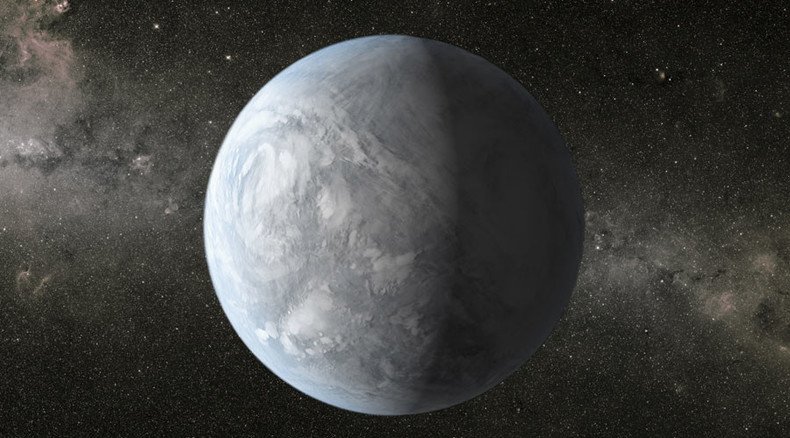‘More habitable planets in 50 yrs’: Earth’s nearest exoplanet discoverer on his plans and hopes

In 50 years, mankind will become capable of discovering potentially inhabited planets as it develops new astronomical instruments that will allow scientists to analyze the planets’ physical characteristics. This is according to Stefan Udry, Swiss astrophysicist and the discoverer of the Earth’s nearest exoplanet.
“I think we will have ways to get a hint on the inhabitance of planets. We will be able to find potentially habitable planets as well as planets already hosting life – those we want to reach. However, this is a long way we are talking about – around 50 years from now.
“Nevertheless, each discovery we are making now is putting a stone on the road we are building to get there,” the exoplanet discoverer, Geneva University astronomy professor Stefan Udry told RIA Novosti news agency.
In order to recognize a planet as a potentially habitable one, scientists need to know its mass, density and size as well as its distance from the star it orbits around. These characteristics would allow astrophysicists to hypothesize about the specifics of the planet’s atmosphere and physical conditions on its surface.
However, existing technologies allow the measuring of only part of the characteristics needed, thus leaving an information gap preventing researchers from making accurate conclusions about the discovered planets.
There are two major techniques for studying the exoplanets’ characteristics in search for potential live hosts. One of them, called radial velocity allows the finding of a planet’s mass as well as the distance between a planet and a star. The second method, named transit photometry, gives data about a planet’s size and density.
'Next-door neighbor’: 2nd exoplanet discovered 21 light-years from Earth http://t.co/x9eFVnmm5bpic.twitter.com/oJup2DfHhp
— RT (@RT_com) July 31, 2015So far, the scientists have not managed to analyze any discovered exoplanet using a combination of the two methods. However, only knowing all necessary characteristics, the scientists could say if a planet has the right temperature for liquid water on its surface to exist as well as the right mass and density to have the atmosphere than is neither too thin nor too thick.
“The idea now is to get all the techniques converged on the same bright star, so we could have all the characteristics of the planets orbiting this star,” Stefan Udry told RIA. “We are on this way, we know what we want to do, the project is ongoing and each step here is an important one.”
Now, the astrophysicists from Geneva University are working closely with scientists from the UK, Portugal and some other countries as well as with the European Space Agency (ESA) to create a wide range of instruments that would enable the scientists to use a complex approach by studying exoplanets.
READ MORE: We are not alone? NASA’s Kepler telescope finds first planet similar to Earth
A new high-accuracy spectrum recorder called “Espresso” and developed by Swiss scientists will be mounted on the ESA’s Very Large Telescope (VLT) in Chili thus making the discovery of new excoplanets much easier.
In ten years, ESA will put into orbit a space telescope called PLATO (Planetary Transits and Oscillations of stars) in order to look for the sun-like stars that could be the centers of planetary systems.
Another ESA project being currently developed is a space telescope, CHEOPS, aimed at studying exoplanets via transit photometry method in order to accurately measure their size and density.
Transit photometry also would allow analysis of the chemical composition of the discovered exoplanets’ atmosphere by studying the changes in star light which courses through it as a planet when it orbits between its star and the Earth.
“At this point we can define the chemical makeup of the planet’s atmosphere but only in the case of the giant planets because they have big atmosphere …and Americans and Europeans are developing a new generation of telescopes – 40-meters wide that would be available in ten years,” Stefan Udry said. “With those, we hope to be able to do the atmosphere characterization of the smaller planets.”
READ MORE: Volcanoes may cause drastic temperature changes on distant super-Earth
“The next step will be direct imaging of the exoplanets… but that is a long shot,” he added.
Stefan Udry was very optimistic about the potential number of planets “that are like Earth” as he said that the Kepler space telescope has already found more than 150,000 stars potentially hosting planets with the scientists assuming that the number of planets in the habitable zones near these stars could reach 20-25 percent of their total number.
“And I am convinced that life [on exoplanets] exists because all the basic constituents of live are made in stars – these are the most abundant elements in the universe,” he said.
Recently, several important discoveries of exoplanets have been made. In late July, NASA astronomers together with a research group from Geneva University, including professor Udry, found an exoplanet dubbed HD 219134b which is 1.6 times larger than Earth and is just 21 light-years from our planet.
Prior to that, NASA scientists discovered a planet, some 60 times larger than the Earth, in a habitable zone of a sun-like star in the constellation Cygnus, 1400 light years away.












